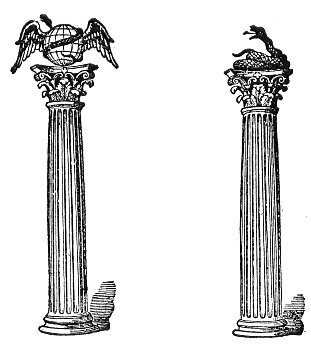All the planets known to the Ancients were distinguished by the Mystic Cross, in conjunction with the solar or lunar symbols; Saturn by a cross over a crescent, Jupiter by a cross under a crescent, Mars by a cross resting obliquely on a circle, Venus by a cross under a circle, and Mercury by a cross surmounted by a circle and that by a crescent.
p. 506
The Solstices, Cancer and Capricorn, the two Gates of Heaven, are the two pillars of Hercules, beyond which he, the Sun, never journeyed: and they still appear in our Lodges, as the two great columns, Jachin and Boaz, and also as the two parallel lines that bound the circle, with a point in the centre, emblem of the Sun, between the two tropics of Cancer and Capricorn.
The Blazing Star in our Lodges, we have already said, represents Sirius, Anubis, or Mercury, Guardian and Guide of Souls. Our Ancient English brethren also considered it an emblem of the Sun. In the old Lectures they said: “The Blazing Star or Glory in the centre refers us to that Grand Luminary the Sun, which enlightens the Earth, and by its genial influence dispenses blessings to mankind.” It is also said in those lectures to be an emblem of Prudence. The word Prudentia means, in its original and fullest signification, Foresight: and accordingly the Blazing Star has been regarded as an emblem of Omniscience, or the All-Seeing Eye, which to the Ancients was the Sun.
Even the Dagger of the Elu of Nine is that used in the Mysteries of Mithras; which, with its blade black and hilt white, was an emblem of the two principles of Light and Darkness.
Isis, the same as Ceres, was, as we learn from Eratosthenes, the Constellation Virgo, represented by a woman holding an ear of wheat. The different emblems which accompany her in the description given by Apuleius, a serpent on either side, a golden vase, with a serpent twined round the handle, and the animals that marched in procession, the bear, the ape, and Pegasus, represented the Constellations that, rising with the. Virgin, when on the day of the Vernal Equinox she stood in the Oriental gate of Heaven, brilliant with the rays of the full moon, seemed to march in her train.
The cup, consecrated in the Mysteries both of Isis and Eleusis, was the Constellation Crater or the Cup. The sacred vessel of the Isiac ceremony finds its counterpart in the Heavens. The Olympic robe presented to the Initiate, a magnificent mantle, covered with figures of serpents and animals, and under which were twelve other sacred robes, wherewith he was clothed in the sanctuary, alluded to the starry Heaven and the twelve signs: while the seven preparatory immersions in the sea alluded to the seven spheres, through which the soul plunged, to arrive here below and take up its abode in a body.
p. 507
The Celestial Virgin, during the last three centuries that preceded the Christian era, occupied the horoscope or Oriental point, and that gate of Heaven through which the Sun and Moon ascended above the horizon at the two equinoxes. Again it occupied it at midnight, at the Winter Solstice, the precise moment when the year commenced. Thus it was essentially connected with the march of times and seasons, of the Sun, the Moon, and day and night, at the principal epochs of the year. At the equinoxes were celebrated the greater and lesser Mysteries of Ceres. When souls descended past the Balance, at the moment when the Sun occupied that point, the Virgin rose before him; she stood at the gates of day and opened them to him. Her brilliant Star, Spica Virginis, and Arcturus, in Boötes, northwest of it, heralded his coming. When he had returned to the Vernal Equinox, at the moment when souls were generated, again it was the Celestial Virgin that led the march of the signs of night; and in her stars came the beautiful full moon of that month. Night and day were in succession introduced by her, when they began to diminish in length; and souls, before arriving at the gates of Hell, were also led by her. In going through these signs, they passed the Styx in the 8th Degree of Libra. She was the famous Sibyl who initiated Eneas, and opened to him the way to the infernal regions.

Moe is the founder of GnosticWarrior.com. He is a father, husband, author, martial arts black belt, and an expert in Gnosticism, the occult, and esotericism.





